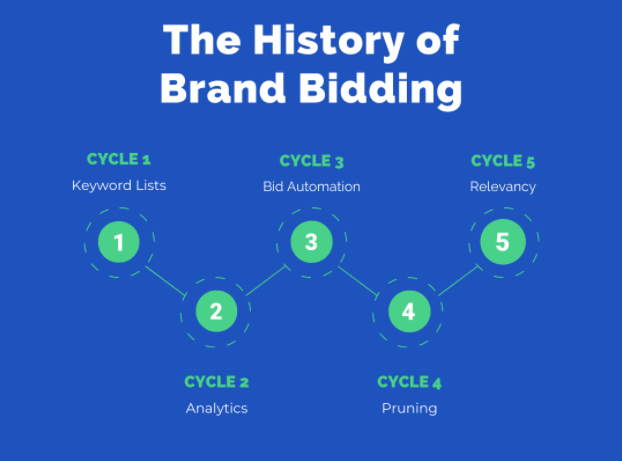Brand protection Lesson #1: Why Is PPC brand protection important and how did we get here?
Thank you for signing up and welcome to the first of our 6 part Crash Course on Brand Protection! In the coming days you will receive additional emails and we'll dig deeper into exactly why you need to protect your Brand, and how to do so. Let's begin!
Unless you are completely new to PPC, it is tough to get the big gains that we once saw. As a marketing tactic, PPC has been mature for years and few “easy wins” still remain. Many categories are dominated by large players (e.g. Amazon), long-tail keywords have become expensive, and the most advanced marketers have complex technology and expensive agencies on their side.
Especially with first-page CPCs on the rise, advertisers are tempted to look for any opportunity possible to reduce costs, and sometimes brand campaigns end up getting the axe. So how do PPC marketers achieve meaningful growth today?
Brand Bidding: Your Secret Weapon
At The Search Monitor, we’ve found a promising solution: brand bidding. Or better said, the process of running an effective brand-bidding strategy focused on revenue growth and protection.
This solution didn’t arrive overnight. Our company reviews ad monitoring data for thousands of branded searches. We’ve verified that competition for branded keywords is on the rise. If our clients simply do nothing, the result has been higher CPCs, lower average rankings, and even instances of advertisers and partners unknowingly working against each other.
Our data has revealed that executing a proper brand bidding strategy provides incredible value to an advertiser. We see that:
- Consumers love branded searches. The volume of branded searches is quite impressive. Using the Google Ads Keyword Planner, for example, we see that in December 2020 alone, there were over 8 million US searches for “the north face” and 606K US searches for “north face jackets.”
- Branded searches convert well. Advertisers receive a large portion of their traffic from branded searches. One of The Search Monitor’s clients, a well-known travel brand, shared that by sponsoring their brand terms they were able to capture two-thirds of the paid search clicks generated by those branded keywords. In other words, if this client were not to sponsor its brand, then it would be giving up 66% of the clicks on its brand terms to competitors.
- Clicks decrease rapidly with more competition. Our data shows that brand owners can lose 50% of their click potential as competitors increase.
- CPCs increase significantly with more competition. We also see that CPCs can jump more than 60% when competitors vie for the top three spots.
- Affiliate competitors distort metrics. Affiliates can throw off bid automation and conversion metrics by 20% or more.
With the volume of brand bidding on the rise, it requires considerable effort and focus to combat it, yet brand protection in PPC can produce giant revenue results. Some of our bigger brand clients have told us that their strategy of protecting branded searches has earned them (or saved from loss) hundreds of millions of dollars annually worldwide.
When we share this message — and especially the revenue figures — with advertisers, the response has typically been: “We’re seeing the same thing, but we don’t know what to do.”
The History of Brand Bidding: How Did We Get Here?
The history of PPC is a short but intense journey. Looking back, we have noticed five distinct cycles in PPC optimization, each with an increasing degree of difficulty. As you read through these five below, ask yourself where you think you currently are — and where you’d like to be.

Cycle 1: Keyword Lists
This initial optimization tactic was focused on the breadth of your keyword list. It was relatively easy because everything was new. Keywords were cheap! When pay-per-click was introduced, quality, decent-volume keywords could be purchased for five cents or less. Even five years later, a search marketer who bid more than a few dollars on a click would be laughed at.
With bid prices so low, search marketers were happy to experiment with the new channel. It was a learning environment, and competition remained low for years. Gains in revenue were tremendous as a result.
Cycle 2: Analytics
After building an exhaustive keyword list, marketers focused on their performance analytics for PPC optimization. They studied CTRs, conversion rates, CPCs and anything else they could monitor, then tweaked their strategies ever so subtly. The addition of advanced analytics enabled PPC gains to remain considerable.
Cycle 3: Bid Automation
After analytics, advances in technology made it easier to automate many of the huge data chores associated with optimization. In particular, the automation of bids let advertisers change their costs in real time to reflect changes in product costs or consumer demand.
Millions of PPC bids could be controlled by bid automation systems, and the quality of the data inputs (the analytics) became even more vital to PPC optimization. This new technology helped usher in the next cycle in PPC optimization.
Cycle 4: Pruning
After gains from analytics and automation were exhausted, the seasoned marketer took an even closer look at their campaigns for available refinements in performance. Engines were constantly rolling out new optimization features for advertisers, and the popular ones were negative match, search queries, and other cost analysis tools. They used these to prune out the big cost drivers that didn’t deliver the performance. Another huge leap of gains happened in cost optimization.
Cycle 5: Relevancy
The most recent cycle in PPC optimization occurred when marketers optimized their campaigns against the new arena of Quality Scores and search engine mandates for relevance. The engines value greater relevancy at all costs and have rewarded those marketers that complied with cheaper CPCs.
Brand Bidding As The Next Cycle
Fast forward to the present day, and marketers are looking for the next tool or technique to generate large gains from PPC performance. The Search Monitor believes that brand bidding is the next cycle in PPC optimization.
* * *
In Lesson #2, we’ll discuss why branded keywords can get you more clicks, better conversion rates, and improve quality scores for your ad account.
Ready to easily monitor competitor & affiliate trademark bidding activity on paid search? Schedule a demo →












